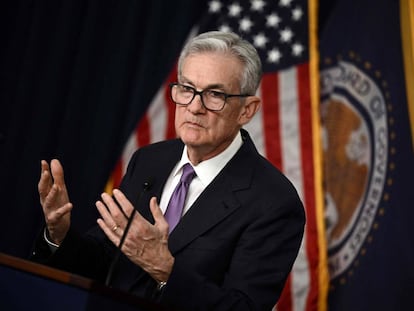US inflation slows but remains elevated in sign that price pressures are easing only gradually
The consumer price index rose 0.3% from December to January, up from a 0.2% increase the previous month. Compared with a year ago, prices are up 3.1%

Annual inflation in the United States cooled last month yet remained elevated in the latest sign that the pandemic-fueled price surge is only gradually and fitfully coming under control.
Tuesday’s report from the Labor Department showed that the consumer price index rose 0.3% from December to January, up from a 0.2% increase the previous month. Compared with a year ago, prices are up 3.1%.
That is less than the 3.4% figure in December and far below the 9.1% inflation peak in mid-2022. Yet the latest reading is still well above the Federal Reserve’s 2% target level at a time when public frustration with inflation has become a pivotal issue in President Joe Biden’s bid for re-election.
Excluding the volatile food and energy categories, so-called core prices climbed 0.4% last month, up from 0.3% in December and 3.9% over the past 12 months. Core inflation is watched especially closely because it typically provides a better read of where inflation is likely headed. The annual figure is the same as it was in December.
Biden administration officials note that inflation has plummeted since pandemic-related supply disruptions and significant government aid sent it soaring three years ago. And a raft of forward-looking data suggests that inflation will continue to cool.
Still, even as it nears the Fed’s target level, many Americans remain exasperated that average prices are still about 19% higher than they were when Biden took office.
The mixed data released Tuesday could reinforce the caution of Fed officials, who have said they’re pleased with the progress in sharply reducing inflation but want to see further evidence before feeling confident that it’s sustainably headed back to their 2% target. Most economists think the central bank will want to wait until May or June to begin cutting its benchmark rate from its 22-year-high of roughly 5.4.
The Fed raised its key rate 11 times, from March 2022 to July of last year, in a concerted drive to defeat high inflation. The result has been much higher borrowing rates for businesses and consumers, including for mortgages and auto loans. Rate cuts, whenever they happen, would eventually lead to lower borrowing costs for many categories of loans.
Fed Chair Jerome Powell noted during a recent news conference that most of the decline in inflation so far has stemmed from lower prices for goods, including used cars, furniture and appliances, which have dropped in six of the past seven months.
By contrast, the costs of services — auto repairs, health care, hotel rooms, concerts and other entertainment — are still rising briskly. Core services prices, which exclude energy, jumped 5.3% in 2023. The Fed will want to see some cooling in services prices to become more assured that inflation is declining.
A rate cut by the central bank typically lowers the costs of mortgages, auto loans, credit cards and other consumer and business borrowing, and could bolster the economy. But a much stronger economy could also pose a challenge for the Fed because faster growth can accelerate wages and consumer spending. If businesses aren’t able to keep up with greater customer demand, they typically respond by raising prices, which would worsen inflation.
In the final three months of last year, the economy grew at an unexpectedly rapid 3.3% annual rate. There are signs that growth remains healthy so far in 2024. Businesses engaged in a burst of hiring last month. Surveys of manufacturing companies found that new orders rose in January. And services companies reported an uptick in sales.
Sign up for our weekly newsletter to get more English-language news coverage from EL PAÍS USA Edition
Tu suscripción se está usando en otro dispositivo
¿Quieres añadir otro usuario a tu suscripción?
Si continúas leyendo en este dispositivo, no se podrá leer en el otro.
FlechaTu suscripción se está usando en otro dispositivo y solo puedes acceder a EL PAÍS desde un dispositivo a la vez.
Si quieres compartir tu cuenta, cambia tu suscripción a la modalidad Premium, así podrás añadir otro usuario. Cada uno accederá con su propia cuenta de email, lo que os permitirá personalizar vuestra experiencia en EL PAÍS.
¿Tienes una suscripción de empresa? Accede aquí para contratar más cuentas.
En el caso de no saber quién está usando tu cuenta, te recomendamos cambiar tu contraseña aquí.
Si decides continuar compartiendo tu cuenta, este mensaje se mostrará en tu dispositivo y en el de la otra persona que está usando tu cuenta de forma indefinida, afectando a tu experiencia de lectura. Puedes consultar aquí los términos y condiciones de la suscripción digital.
More information
Archived In
Últimas noticias
The metaverse, four years later: Is it finished or just at a standstill?
$3,000 and a plane ticket: The United States increases incentives for migrants to self-deport before the end of the year
Charles Dubouloz, mountaineering star, retires at 36 with a farewell tour inspired by Walter Bonatti
From the White House to diplomatic gifts: Lego wins over adult fans, brick by brick
Most viewed
- The low-cost creative revolution: How technology is making art accessible to everyone
- Families demand repatriation of bodies of Colombians who died in Ukraine: ‘This war is a slaughterhouse for foreigners’
- Christian Louboutin: ‘Young people don’t want to be like their parents. And if their parents wear sneakers, they’re going to look for something else’
- All the effects of gentrification in one corner of Mexico’s Colonia Roma
- Christmas loses its festive spirit: ICE fears cast shadow over religious celebrations










































